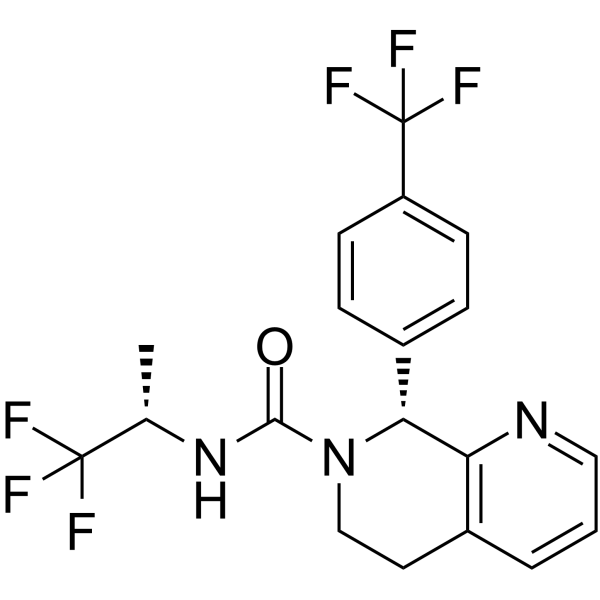
AMG2850
CAS No. 1470018-52-0
AMG2850( —— )
Catalog No. M26053 CAS No. 1470018-52-0
AMG2850 is a potent, orally bioavailable, and selective antagonist of transient receptor potential melastatin 8 (TRPM8).
Purity : >98% (HPLC)
 COA
COA
 Datasheet
Datasheet
 HNMR
HNMR
 HPLC
HPLC
 MSDS
MSDS
 Handing Instructions
Handing Instructions
| Size | Price / USD | Stock | Quantity |
| 5MG | 295 | Get Quote |


|
| 10MG | 507 | Get Quote |


|
| 25MG | 802 | Get Quote |


|
| 50MG | 1107 | Get Quote |


|
| 100MG | 1503 | Get Quote |


|
| 200MG | Get Quote | Get Quote |


|
| 500MG | Get Quote | Get Quote |


|
| 1G | Get Quote | Get Quote |


|
Biological Information
-
Product NameAMG2850
-
NoteResearch use only, not for human use.
-
Brief DescriptionAMG2850 is a potent, orally bioavailable, and selective antagonist of transient receptor potential melastatin 8 (TRPM8).
-
DescriptionAMG2850 is a potent, orally bioavailable, and selective antagonist of transient receptor potential melastatin 8 (TRPM8).
-
In Vitro——
-
In Vivo——
-
Synonyms——
-
PathwayMembrane Transporter/Ion Channel
-
TargetTRP/TRPV Channel
-
RecptorParasite
-
Research Area——
-
Indication——
Chemical Information
-
CAS Number1470018-52-0
-
Formula Weight417.355
-
Molecular FormulaC19H17F6N3O
-
Purity>98% (HPLC)
-
SolubilityIn Vitro:?DMSO : 100 mg/mL (239.61 mM)
-
SMILESC[C@H](NC(=O)N1CCc2cccnc2[C@H]1c1ccc(cc1)C(F)(F)F)C(F)(F)F
-
Chemical Name——
Shipping & Storage Information
-
Storage(-20℃)
-
ShippingWith Ice Pack
-
Stability≥ 2 years
Reference
1.Smullen S, McLaughlin NP, Evans P. Chemical synthesis of febrifugine and analogues. Bioorg Med Chem. 2018 May 15;26(9):2199-2220. doi: 10.1016/j.bmc.2018.04.027. Epub 2018 Apr 12. Review. PubMed PMID: 29681487.
molnova catalog



related products
-
JC-229
JC-229 is a potent and selective TbRPA1 inhibitor that can inhibit RPA1 in Trypanosoma brucei. JC-229 can be used to study human African Trypanosomiasis (HAT).
-
CIM0216
CIM0216 is a synthetic TRPM3 activator whose potency and apparent affinity greatly exceeds that of the canonical TRPM3 agonist.
-
EIPA
EIPA (L593754, MH 12-43) is a TRPP3 channel inhibitor (IC50: 10.5 μM). It also inhibits Na+/H+-exchanger (NHE) and macropinocytosis.It is found that EIPA, benzamil, and phenamil rapidly and reversibly block Ca2+-activated TRPP3 channel activation at -50 mV, with IC50s of 143, 10.5, 1.1, and 0.14 μM, respectively.



 Cart
Cart
 sales@molnova.com
sales@molnova.com


